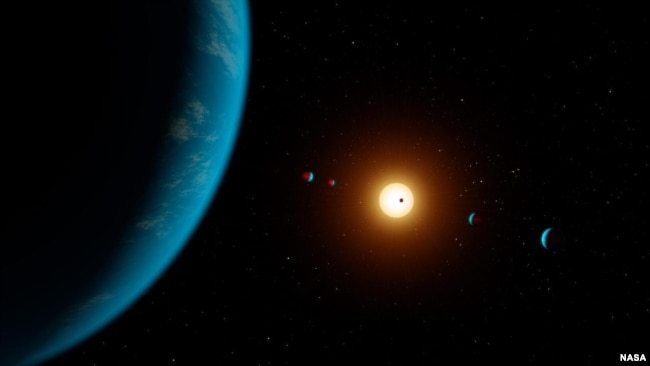AI,301個の太陽系外惑星を確認
時には宇宙に心を遊ばせる。
そんな瞬間が心を満たしてくれます。
今回もVOAで英語を学び、世界を学びましょう!!
This illustration shows the seven-member TRAPPIST-1 planetary system as the planets might look as viewed from Earth using a fictional, incredibly powerful telescope. (Image credit: NASA/JPL-Caltech/R. Hurt (IPAC))
架空の強力な望遠鏡を使って、地球から見た7つの惑星系「TRAPPIST-1」の姿を描いたもの。(画像提供:NASA/JPL-Caltech/R. Hurt (IPAC))
米航空宇宙局(NASA)は、新技術を用いた手法により、新たに301個の太陽系外惑星の存在を確認したと発表した。
太陽系外惑星とは、太陽以外の恒星の周りを回っている惑星のこと。今回の発見以前に、NASAは4,569個以上の太陽系外惑星の存在を確認していました。他にも数千個の太陽系外惑星の”候補”が確認されています。しかし、これらはさらなる研究が必要です。
この機械学習システムは、NASAの研究者とチームの国際的なパートナーによって開発・テストされました。Astrophysical Journal誌に掲載された論文で紹介されています。
太陽系外惑星は、望遠鏡で識別するのが難しいのです。その理由の一つは、軌道上にある星の明るい光で隠れてしまうからです。そのためには、恒星の光量が減少していないかどうかを確認する必要があります。これは、惑星が星の前を通過したときに起こる可能性があります。
NASAは2つの宇宙望遠鏡を使って、数千個の太陽系外惑星を確認しました。ケプラー宇宙望遠鏡は2009年に打ち上げられ、2018年10月まで運用されました。その際、NASAはケプラーを退役させることを発表しました。"さらなる科学運用に必要な燃料が尽きた "という理由からです。
もう1つの宇宙望遠鏡は、Transiting Exoplanet Survey Satellite(TESS)と呼ばれています。NASAは2018年4月にTESSを打ち上げ、ケプラーの観測を発展させました。TESSは現在も運用を続けています。
ASAが新たに301個の太陽系外惑星を確認したのは、宇宙望遠鏡「ケプラー」が収集したデータに基づいています。このデータは、ExoMinerと呼ばれる機械学習システムによって処理されました。
機械学習システムは、人工知能(AI)の一種です。膨大な量のデータを与えられることで、時間をかけてタスクを学習するように訓練されます。
今回のケースでは、NASAは機械学習法を使って既存のデータを調べ、いわゆる "偽者 "から本物の太陽系外惑星を識別したといいます。
ExoMinerは、過去に行われた太陽系外惑星の確認や除外の取り組みから得られたデータを基にしています。このシステムは、人間の専門家が新しい太陽系外惑星を確認するのと同じ方法を使用するように設計されています。
NASAによると、このシステムは、惑星の存在を確認するために専門的な訓練を受けた科学者たちにとって、非常に必要な支援となります。同局の宇宙望遠鏡は、何千もの星のデータを収集しています。これだけの数の星を人間が調べるのは大変な労力を必要とします。ExoMinerは、その負荷を軽減し、新しい系外惑星を特定する精度を向上させるために設計されています。
ジョン・ジェンキンス氏は、カリフォルニア州にあるNASAエイムズ研究センターの太陽系外惑星科学者です。同氏は声明の中で、ExoMinerは、過去に太陽系外惑星を特定するために使用された他の機械学習プログラムに比べ、大きな改善をもたらしたと述べています。
その主な理由は、この新しいシステムによって、科学者たちがExoMinerの結果を簡単に確認できるようになったことだとジェンキンス氏は言います。
ジェンキンス氏は、「ExoMinerがなぜ惑星であるかどうかを判断したのか、その理由は謎ではありません」と語ります。「私たちは、データのどの特徴がExoMinerに惑星を拒否させたり、確認させたりするのかを簡単に説明することができます」。
この機械学習システムは、NASAの研究者とチームの国際的なパートナーによって開発・テストされました。その内容は、Astrophysical Journalに掲載された論文によって説明されています。
論文によると、ExoMinerは、ケプラー宇宙望遠鏡のデータに基づく候補リストから、301個の太陽系外惑星を発見しました。これらの惑星は、ケプラーサイエンスオペレーションセンターの科学者によって特定され、太陽系外惑星の可能性があると宣言されていました。しかし、NASAによると、人間の研究者がそれらを確認することはできなかったといいます。
「ExoMinerが惑星だと言えば、それが惑星であることを確信できます」とハメッド・バリザデガン氏は言います。ハメッド・バリザデガン氏は、ExoMinerプロジェクトのリーダーであり、エイムズセンターにある大学宇宙研究協会の機械学習オペレーションを統括しています。
ヴァリザデガン氏は、このシステムは、既存の機械学習法や人間の専門家よりも”ある意味では信頼性が高い”と付け加えています。その理由のひとつとして、ExoMinerには人間の識別作業に影響を与える”バイアス”がないことを挙げています。
NASAのチームは、ExoMinerの成功をもとに、システムを拡張することを計画しています。その目的は、TESSや、新しい太陽系外惑星の発見を目指す将来の望遠鏡からのデータを含めることである。
Machine Learning Helps NASA Confirm 301 New Exoplanets
The American space agency NASA says it has used a new technology method to help confirm the existence of 301 new exoplanets.
Exoplanets are planets that orbit stars other than the sun. Before the latest discoveries, NASA had confirmed the existence of more than 4,569 such planets. Thousands of other “candidate” exoplanets have been identified. But these require additional study.
Exoplanets are difficult for telescopes to identify. One reason is that the bright light of the stars they orbit can hide them. The search process can involve looking for decreases in the light level of stars. Such drops could be caused by a planet passing in front of a star.
NASA has used two space telescopes to confirm thousands of exoplanets. The Kepler space telescope was launched in 2009 and operated until October 2018. At that time, NASA announced it was retiring Kepler because the spacecraft had “run out of fuel needed for further science operations.”
The other space telescope is called the Transiting Exoplanet Survey Satellite, or TESS. NASA launched TESS in April 2018 to build on Kepler’s observations. TESS continues to operate today.
NASA’s confirmations of the 301 new exoplanets were based on data collected by the Kepler space telescope. The data was processed through a machine learning system called ExoMiner.
Machine learning systems are a form of artificial intelligence (AI). They are trained to learn a task over time by being fed huge amounts of data.
In this case, NASA said it used the machine learning method to examine existing data to identify real exoplanets from so-called “imposters.”
ExoMiner is powered by data gathered from past efforts to confirm or rule out possible exoplanets. The system was designed to use the same methods that human experts use to confirm new exoplanets.
NASA said the system provides much-needed assistance to scientists who are expertly trained to confirm the existence of such planets. The agency’s space telescopes collect data on thousands of stars. It is a huge effort for humans to examine so many stars. ExoMiner is designed to ease that load and improve the accuracy of identifying new exoplanets.
Jon Jenkins is an exoplanet scientist at NASA’s Ames Research Center in California. He said in a statement that ExoMiner offers big improvements over other machine learning programs used to identify exoplanets in the past.
The main reason for this, Jenkins said, is that the new system permits scientists to easily confirm ExoMiner’s findings.
“There is no mystery as to why it decides something is a planet or not,” he said. “We can easily explain which features in the data lead ExoMiner to reject or confirm a planet.”
The machine learning system was developed and tested by NASA researchers and the team’s international partners. It was described by a paper published in the Astrophysical Journal.
The paper explains that ExoMiner discovered the 301 exoplanets from a list of candidates based on data from the Kepler space telescope. They had been identified and declared as possible exoplanets by scientists at the Kepler Science Operations Center. But NASA said no human researchers had been able to confirm them.
“When ExoMiner says something is a planet, you can be sure it's a planet,” said Hamed Valizadegan. He is the ExoMiner project lead and oversees machine learning operations at the Universities Space Research Association at the Ames center.
Valizadegan added that the system is “in some ways more reliable” than both existing machine learning methods as well as human experts. He said one reason for this is that ExoMiner is free of “biases” that can affect human identification operations.
The NASA team said it plans to build on ExoMiner’s success by expanding the system. The goal would be to include data from TESS and future telescopes that aim to discover new exoplanets.
Words in This Story
artificial intelligence – n. an area of computer science that deals with giving machines the ability to seem like they have human intelligence
imposter – n. someone who pretends to be someone else in order to trick people
accuracy – n. correct or exact
feature – n. a typical quality or important part of something
reliable – adj. able to be trusted or believed
bias – n. prejudice in favor of or against one thing person or group compared with another
